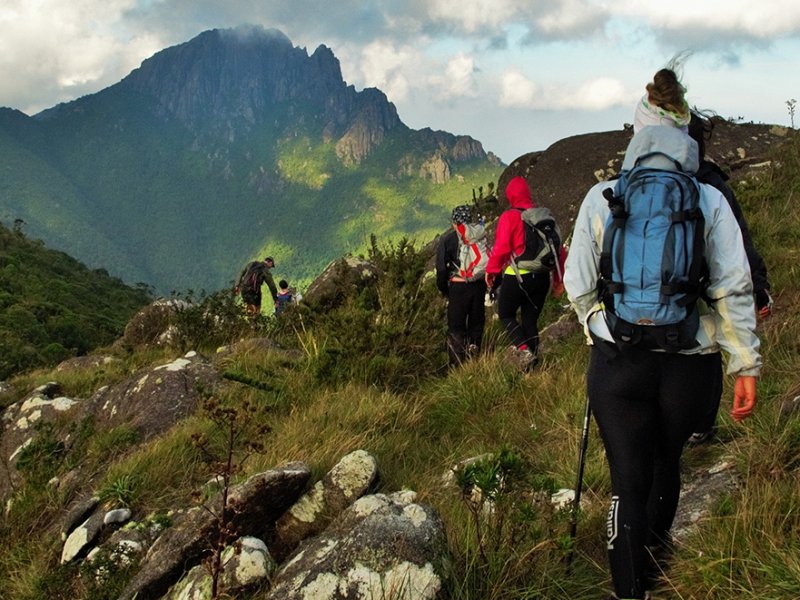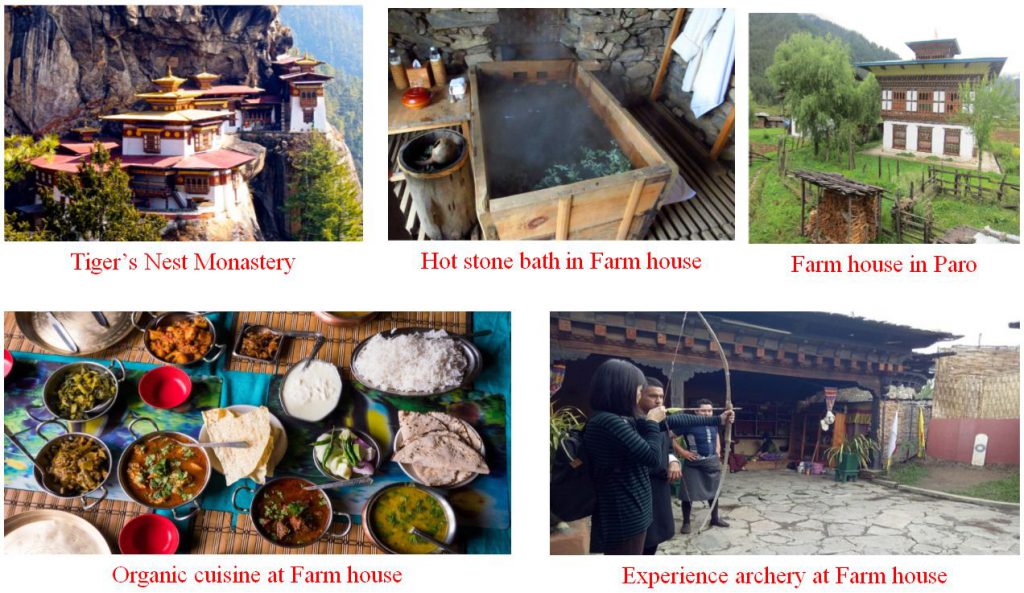

Description : This six day trek takes you into an area adorned with a multitude of pristine, crystal clear lakes.
As you walk amidst the shimmering lakes you’ll be treated to stunning views of the entire Himalayan mountain range and some of the world’s highest peaks including Mt. Everest, Jomolhari, Masang Gang, Jichu Drake, Gangche Ta and many more.
During the trek an entire day will be dedicated to visiting some of the more picturesque lakes and resting. The trail also takes you through several Bhutanese villages so you can get a good idea of traditional Bhutanese village life as you make your way back from the lakes.
While this is a somewhat strenuous trek, it is well worth the effort because of the tranquility and beauty of natural landscape that you will enjoy during the journey. The best time to embark on this trek is between April-June or September –October
DAY 1: ARRIVE PARO, SIGHTSEEING
Fly into Paro by Druk Air, Bhutan’s National Airline. The great snow-capped peaks of the inner Himalayas rise up to the heavens can be seen during clear weather. As the plane approaches Bhutan, if you look down farm houses as dots on the hillsides can be seen.
You will be received by the representative of Yelha Bhutan Tours and Travels (Bhutan tour operator) who will be your Bhutan travel guide throughout your tour.
After meeting with the guide and driver, drive to hotel and visit Paro Rinpung dzong, built in 1645 to defend the valley against Tibetan invaders. The Dzong is now being used as an administration center and school for monks. Visit Taa dzong which was built in the 17th century as a watch tower for the Paro Dzong. This dzong was converted into the National museum in 1967.
Overnight at Paro

The route is part of the original mule track that linked Thimphu Valley with Paro Valley and ultimately connected Bhutan to the Indian border. The walk is always done from Paro to Thimphu, as baggage horses are only available in Paro. It is a much more exciting way of reaching Bhutan’s capital and after five days’ trekking the sense of anticipation is keenly felt.
The walk starts appropriately behind Paro Dzong itself. Starting from the watchtower, the path winds its way slowly and evenly upward, through the forest towards the ridge line of the Himalayan foothills above. As the day passes, the views below of the highly cultivated Paro Valley, the Queen Mother’s Winter Palace, and the monastery/fortress itself are wonderful.
The walk is firstly through pine, then bamboo, followed by birch and finally rhododendron. You may have lunch near a Mani wall. The camp site is just a few hundred feet below Jili Dzong in a clearing. You will see plenty of interesting flora and fauna throughout the day and many interesting birds.
It is a short twenty minute hike from the camp to the dzong. This is a large monastery and supposedly haunted. It contains a huge statue of Padma Sambhava.
There are birds nesting in the arrow slits and old Mongol helmets and shields hanging on the walls. The building was until very recently deserted, but has now undergone some renovation and is in use again.
It sits astride a ridge, which affords dramatic views of the valleys on both sides and the Himalaya to the north. On a clear day the second highest mountain in Bhutan can be seen, Mt. Chomolhari, 7,314m.
The path now follows a ridge for a short while before descending into forest. It then follows a snake-like route on rather magical paths, along mountainsides and through many different types of rhododendron. Occasionally you may meet local yak herdsmen and take in wonderful views of mountains, including another large peak called Kangcheeta.
You will see this mountain has two peaks and is split by a straight, pronounced gully, locals believe that Kangcheeta is the brother of Chomolhari (female mountain goddess) who hit him with a stick because he wanted to marry her.
To the south, the Dagala range dominates the skyline. Below Mt. Kangcheeta there is a temple, Tshomphu Monastery, where an idol is supposed to float in the air.
In the past our guides said they had visited the temple and it was possible to pass a string underneath the statue, thus proving it floated. Eventually, you pass through a number of yak herder clearings, stopping for the night at the largest of them.
From camp the path ascends to gain the ridge and then traverses along it, first one side and then the other, with wonderful mountain views.
Eventually you cross a small pass and circle round, until above Jimi Langtsho Lake. This is a large beautiful lake, stocked with trout, with a large chorten (religious obelisk) built at one end. You zigzag down to the lakeside, which is thick with rhododendron and hemmed in by rocky bluffs.
The path then leads up from the lake and along cliff paths with massive drops below. Eventually it leads round a succession of ridges until you arrive at the second lake, Jana Tsho, another magical campsite.
Again a lovely walk in glorious high mountain country, crossing the highest pass, the Simkota La 4,210m/13,812ft. From the lake a wide stone path between rhododendrons leads to traversing a basin, which contains the 3rd lake. Two other lakes are above and out of sight, one male, one female and collectively they are called Dungkar Tsho.
The latter of these has a very strong spirit and if anything ‘dirty’ is done nearby cloud comes down and only goes away with many prayers. The path is a mixture now of small passes, mountain tracks, some of which wander underneath cliffs. You may meet monks on their way from Thimphu to
visit the sacred lake of Jimi Langtsho, where they meditate for a few days before returning. The rocky mountain next to the highest pass, Thujedraj, used to be used for sky burials in the old days. Lower down there is one smaller pass with a chorten which looks directly down onto Thimphu.
Here you will have lunch (31⁄2 hours to here) and then the path zigzags down to Phadjoding. There is time to rest, wash and then see the temples. There is a recent one, constructed with funds donated by the 4th King’s
Secretary, dedicated to Padma Sambava, but the 9th and 16th Je Khempos (head monk of Bhutan) built the two main ones. These are gorgeous buildings with golden roofs and acolyte monks will show you the inner temples.
Phadjoding is a great meditation centre and there are a number of houses dedicated to retreat. A particular type of branch is put outside the front door, showing that the incumbent is not to be disturbed. High up on the cliff behind Phadjoding is a famous hermit temple, built many hundreds of years ago and still used today.
It only takes two or three hours to reach the road, descending, steeply at times, through the forest, on a well worn path. It is worth getting up early for the clear views of the Eastern Himalaya.
Seen clearly on the horizon behind the temples is the highest mountain in Bhutan, Gangkar Punsum, at 7,550m/24,770ft now the highest unclimbed peak in the world. There are several paths leading down to Thimphu; perhaps the best is the one leading to the Radio Station, which takes about 3 hours. Quite often the valley below may be filled with cloud, with just the mountains poking up into the clear air.
Your vehicle will meet you at the road head for the short transfer to your hotel in town.
After reaching Thimphu, check into the hotel and take shower or rest for a while and stroll through through Thimphu town in the evening.
After breakfast we have a full day Thimphu tour which includes visit to the following:
In the afternoon drive to Paro.
Overnight at a hotel in Paro.
After breakfast, drive up to the base camp of Taktsang and then hike up to the most famous Monastery in the entire kingdom of Bhutan perched on the edge of a steep cliff, about 900 meters above Paro Valley.
The hike to the viewpoint will take about an hour and it will take 2 hours to the monastery. Till view point, you can experience horse ride by paying USD 15 to USD 20 per horse but if you prefer hike, then it is great.
Lunch at Taktshang Café just above view point or you can have picnic lunch.
After completing the hike, you will be visiting one of the farm houses in Paro to experience Bhutanese life-Style and the organic Bhutanese dinner.
You can also experience hot-stone bath at farm house (US $ 20 per person).
It is a good remedy for skin diseases, joint pains, body aches and to relax after a hard day’s work.
No scientific study has been done but it’s believed that the herbs and the chemical in the stones are a good source of medicine. Families in olden days would soak after their seasonal farm work in winter. The long, healing bath relaxed their tired bodies and helped cure backaches and joint pains.
In the evening relax and overnight at a hotel in Paro.

In the morning tour guide from Yelha Bhutan Tours will escort you to the Paro airport for your flight to your onward destinations.